
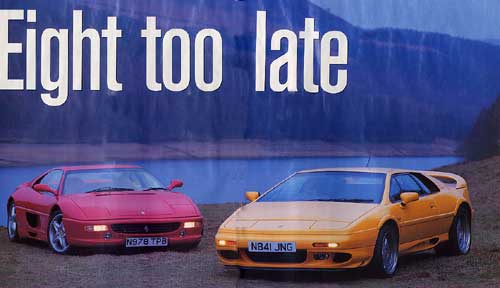
Lotus's
Esprit has beeen crying out for this new V8.
So have its Ferrari-bashing days returned?
AutoCar May 1996
Andrew Frankel takes the wheel
It was a day we'd been looking forward to for more than the obvious reasons. No one charged with spending time in the Peak District with a Ferrari F355 and a Lotus Esprit is likely to rank high on any list of people to be pitied. But, jetting north from London in the Ferrari, the thought of the Lotus with Steve Sutclife at the wheel, westbound from the factory headquarters in Norfolk, was a good deal more than usually thrilling.
This was going to be a classic; and not simply because Esprits have, in one form or another, been slogging it out with Ferrari's Pininfarina-styled babies for rather more than 20 years. What made this the confrontation we have waited a generation for is that the Lotus, for the first time ever, was wading into war on at least equal terms, For, in the back of Sutcliffe's Esprit was no age-old small capacity four-cylinder motor granted on last favour from its deathbed but, instead, Lotus's own 3.5-litre V8, developed in-house in just 27 months.
Think of it, An all-new engine compared with that in the Ferrari which can trace its design ancestry back to the early '70s; an all-new engine with the same capacity as the F355, the same four camshafts but with two Garret T25 turbochargers where the Ferrari boasts merely a single extra valve per cylinder.
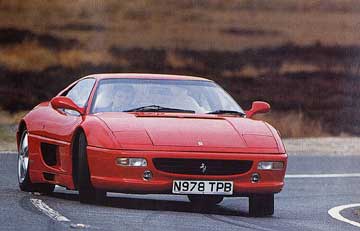
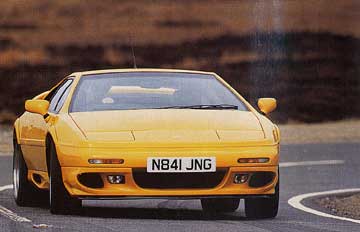
But it was not the thought of this new powerplant, nor the knowledge that it has been squeesed into one of the finest handling road car chassis of our time which bred the anticipation. Rather, it was the thought of what this car as a whole, complete with tis £59,995 list price, was going to do to the £92,657 Ferrari. It was, I hoped, going to prove at least and at last the convincing opposition that is erstwhile rivals from Porsche and Honda, in particular, have so signally failed to provide.
In the unlikely event that you stumbled across a V8 Esprit in the near future (they are to be built at a rate of just 400 per year to satisfy all markets), do not feel bad about failing to notice the fact. If you miss the V8 badge on the back and side windows, you'll have only a more extravagantly styled front spoiler, complete with natty winglets, to tell it apart from its four-cylinder brethren. Peer inside and you'll be unusually lucky or well-informed to spot the difference over a stock and now defunct S4s. There's a V8 badge on the re-counter and the speedo now reads up to 180mph; that's all.
Lift the rear hatch, though, and you'll see all right. Visually, the engine is a masterpiece. What strikes first, once you have pored over the scarlet plenum cambers and cam covers, is the engine's compatness. Glance at the Ferrari's less attractive motor and you'll marvel at how Lotus has installed its engine with is extra turbos into so tiny a slot, leaving room behind for a remarkably big boot in a space where, in the Ferrari, you'd have a job stowing a comb.
And do not associate its diminutive porportions with any lack of power. Out of the box, this V8 develops 349bhp at 6500rpm, some 50bhp more than any previous road-going Esprit. And if you rightly point out the Ferrari's phenomenal 380bhp achievement from the same capacity with a turbo in sight, I might also mention the Ferrari's extra 42kg, meaning, with a power to weight ratio of 253bhp per tonne, the Lotus gives the Ferrari a mere 15bhp per tonne advartage. Consider also that, with 295lb ft of torque at 4250rpm, compared with the Ferrari's 268lb ft at a startling 6000rpm, the Lotus leads the toruque to weight race by 25lb ft per tonne. And so it is abundantly clear that, if anything, it is the British car which should hold the straight-line advantage.
This would seem to support Lotus's ambitious claim that the Esprit V8 requires less than 4.5 sec of your time to carry you from rest to 62mph, while we know the F355 needs 4.6sec to reach just 60mph. Then again, both Lotus's claim for the Esprit and our timing of the F355 reveal an identical 80-100mph time in fourth of 3.6 sec while Lotus's claimed maximum of 175mph is just 2mph ahead of the 173mph the Ferrari recorded on a banked bowl and, therefore, operating at least 10mph shy of its true potential.
What this sea of statistics fails even to hint at, though, is the nature of Lotus's new engine. The truth is that, however fine it looks on paper and however fast it will chuck the Esprit down any stretch of road you point it at, it lacks almost entirely the character cars such as this cry out for.
I am not sure what I should have expected after 200 miles in the company of the F355 and its howling, screaming V8, but it was more than this. Twist the key long enough for the Lotus-designed electronics to fire up the engine and it soon settles down to a smooth but bland idle; aurally, this is as good as it gets. Forget any idea of a V8 burble: for its better poer output, Lotus chose to design the engine with a flat-plane crankshaft so it sounds, in effect, like two four-cylinder engines, not one V8. This, in itself, is no bar to aural excitement as anyone who has driven any V8 Ferrari or even a TVR Cerbera will attest; but add the muffling effect of those two Garrett turbos and the result is a car offering considerably less stimulation in its engine note than the cheapest new Honda Civic.


This was not the first acquaintance I had hoped for. Still, the day was long and the moors quiet. You need just the shortest stretch of road to discover something else the figures scarcely suggest: the Lotus is considerably quicker than the Ferrari. There's not much to tell between them in the first and second gear because, unless you know the sneaky programming bypass Lotus has hidden deep in the engine's electronics, turbo-boost is limited to rather less than 0.5bar until third is selected. Thereafter, unless you are running at under 2500rpm, the Lotus will haul surely away from the Ferrari in any given gear until the Italian passes its torque peak and heads for its extraordinary 8500rpm red line, a period during which it will hold station with the Briton, but no more. The Lotus asks for the next gear at 7000rpm and sets its limiter soon after.
No doubt, this engine is markedly more flexible than the four, spinning its turbos up to speed nearly 1000rpm earlier and reacting more swiftly to commands from the throttle. It achieves this by using two small turbos instead of one big one and eschewing the use of intercoolers, good for producing more grunt ( which, incidentally, would push the gearbox beyond its limitations) but not for throttle response. What it is not, however, is a match for the Ferrari motor in any measure save brute force. Where the F355 possesses the finest road-going eight-cylinder engine in production, with a note and throttle repsonse scarcely removed from the race-track, the Esprit's toneless voice and, by comparison, slack reactions make it no more than an effective, but soulless machine tool.
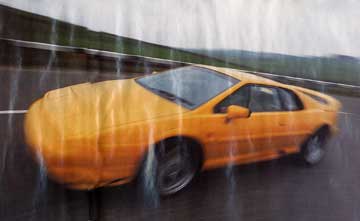
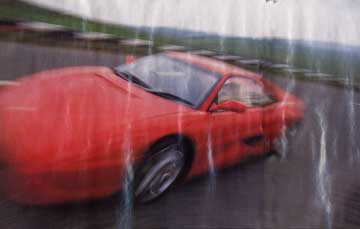
Nor is it helped by its gearbox, still the confounded Renault-sourced device that has compromised so many Esprit driving experiences. Lotus has rightly taken advantage of the V8's flexibility to raise its fifth and final ratio to provide more relaxed cruising but, if anything, the change quality on our test car was even worse than my memory recalled. It stands little comparison with the way the Ferrari's gear-lever snaps and scraps around its open, six speed gate.
Not for the first time in its career, the Lotus has to count on the support of its chassis for salvation. The suspension has been modified only to compensate for the extra 50kg the new engine means it must carry. You have to look exceptionally hard before gaining even the slightest suspicion that the added weight has caused any deterioration in this chassis' abilities.
Wearing the same 285/35 ZR18 rear tyres as the old S4s, it grips a little harder than the Ferrari on its 265/40 ZR18 boots, though, on really rough roads taken at maximum effort, it is the Italian with its computer controlled dampers which best controls the movement of its body.
But this is to reckon without the steering of these two and here the Lotus, with the finest power steering of any car, is dominant. In the four crucial measures, weight, feel, gearing and precision, it humbles the undergeared, too light and comparatively uncommunicative Ferrari wheel. It brings a level of reassurance to that slippery downhill bend you'll not find in the F355, and a sublime ease and enjoyment to simply rowing it through curves on your fingertips at a gentle 70-80mph. And even though the Lotus rides with considerably less aplomb than the often eerily smooth Ferrari, there is no doubt that, taken as a whole, it is the Esprit which is the better handling car.
There is less to tell between their relative braking ability. By the standards of normal road cars both lose speed at an extraordinary rate. And, as the Lotus has taken this opportunity to fit new Kelsey-Hayes abs, you can forget the old criticisms of Esprit brakes. In fact, it is only when you consider the brakes of the Porsche 911 that these two seem at all deficient, neither possessing the German's pedal feel and progression.
For the Lotus, it would be opportune for the contest to end there. It has proven swifter both down the straights and round the corners than the Ferrari. And while the F355's mechanical charisma alone will justify its 50% higher list price for some, I can equally see that, for many, this is slight justification for so great an outlay.
Supercars, however, are not simply about straights and corners. They are also about a sense of occasion and visual beauty and purpose. Here, the Ferrari appears worth every extra penny. See the Lotus on its own and its low and urgent lines still look great. Wheel the Ferrari in next door and the clarity of the Esprit's original shape fades against the simple beauty of the Ferrari until all you see are the addenda: huge rear wing, tacked on wheel-arch extensions, jutting chin and scoops in the sills. The F355, on the other hand, is perhaps the prettiest supercar on the market.
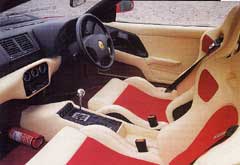
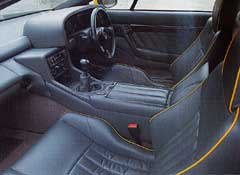
Inside, the Ferrari's cabin goes way beyond the requirements of mere function. In fact, it actually looks better than it works with the finest leather and detailing failing to cloud the essential truth that its driving position is compromised not only by drastically offset pedals but also an inadequately short steering column. Were there more room in the Lotus, its driving position would actually better the Ferrari's; but so cramped is the pedal box and so limited is both head and leg room that anyone of six feet or more is inevitably going to find more comfort in the Ferrari.
There are two extreme ways of looking at the Esprit V8. Existing Esprit devotees will see it as providing more of an already good thing. They will argue that £60,000 is not such a great price to pay for putting such dazzling performance in an already legendary chassis and, when viewed against the S4s, which cost just £7,000 less, it's clear the Esprit's performance to money ratio has never been higher. The Ferrari, it will be said, is irrelevant not simply because it cost half as much again but also because it priorities cosmetic appeal ahead of outright performance and handling. As arguments go, you have to say it has merit.
The less sympathetic view says the Esprit V8 is a crushing disappointment, a car which provides more of the one raw ingredient the four-cylinder car never lacked, speed, yet leaves intact the faults that infect the car, from its ghastly gearbox to tis cramped cabin. Sure, throttle response has been improved, but it remains considerably less than halfway between a four-cylinder Esprit and the engine of, say, a 911 or F355. The reason the Ferrari costs so much more is simply because it is worth it. Dynamically, it comes close enough to the Lotus for the performance differential to be inconsequential in all bar race conditions, while qualitatively it is like comparing fast food to a meal in a three rosette Michelin restaurant: both will fill you up, but you don't need to ask why one costs more.
Present the Esprit V8 to Lotus in such a merciless light and you will be told that there was not the money to completely re-engineer the car from the end to end and that it chose to get the basis (i.e. the engine and chassis) right before moving on to the transmission and styling. You will be told the engine is a fantastic example of compact, prudent engineering which, while not close to its true potential right now, will set Lotus in good stead well into the 21st century. It is efficient, economical, and clean, and it passes every single forseeable emissions test on the horizon.
I doubt not one word of this. But still the Esprit V8 worries me. I came to it hoping to find an engine to match its chassis. I figured that, as Lotus's engineers know better than anyone that there's more to making a car handle than giving it lots of grip, similarly the engine would acknowledge that, when it comes to driving pleasure, there's more to a world leading engine than neck-straining acceleration. As Ferrari recognises, the response and sound of an engine is every it as important as its power output.
And even if you remove the Lotus from the unfavourable light reflected by the Ferrari, it comes across, at best, as a car to delight those already converted to the Esprit faith and acclimatised to its enduring foibles. This, unquestionably, it will do. But as a car to take the Esprit where it deserves, returning to the days when it was scourge of the V8 Ferrari, it falls sadly short of the mark.
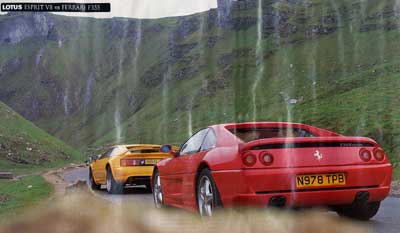

|
|